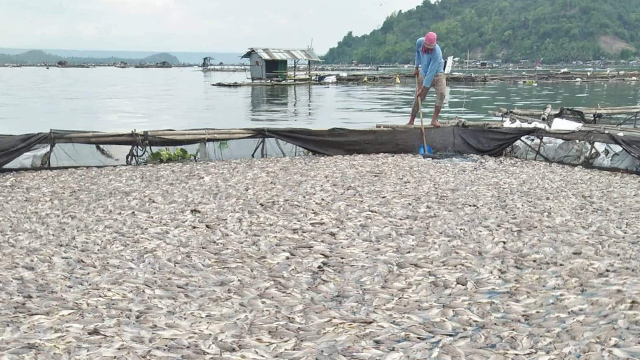
BATANGAS, Philippines – The Taal Lake fishcage industry is facing its worst crisis yet with 605 metric tons of tilapia found dead as of Friday, May 31.
At a farm gate price of P71 per kilo of tilapia, the potential income loss is estimated at P42.9 million.
At an emergency executive committee meeting Friday morning, the Bureau of Fisheries and Aquatic Resources (BFAR) reported the continuous plummeting of the level of dissolved oxygen (DO), which has reached 0.33 parts per million (ppm) at the surface of Taal Lake and 0.66 ppm at the bottom. The agency said the normal DO level should be between 5 to 6 ppm at which fish breathe.
BFAR issued warnings last Sunday, May 26, when the DO reached a dangerously low level of 2.8 ppm. Fish cage owners were advised to move their cages or harvest early.
On Monday evening, about 10 cages were reported to have had mortality. By Thursday afternoon, May 30, in an inspection by Department of Environment and Natural Resources Regional Executive Director Maria Paz Luna, 33 cages still had floating dead fish waiting to be hauled to shore and buried as the newly dug mortality pits were at over capacity.
“Not all fish cage owners are capable harvesters, since they do not own large boats for hauling. The harvesters are currently hauling dead fish from their own cages. Existing boats will also temporarily serve as aerators until water quality improves,” Luna said.
The regulation of the fish cage industry started in 2006, when the carrying capacity was established and 6,000 cages were decreed to be allowed. The Unified Rules and Regulations were passed by the Taal Volcano Protected Landscape and Management Board (TVPL PAMB), and dismantling started in earnest with the help of the Batangas provincial government and its newly created task force.
By 2011, what was once 14,000 cages were down to 6,000, even dipping below that during certain periods.
But Luna said not all rules were followed.
“Stocking density was routinely violated and regulators had no way to count the fish already in the cages. Required certifications that owners had mortality pits for daily mortality and fish kills were falsified. Rules requiring floating feeds, the excess uneaten of which will merely be eaten later, took years to reach critical mass of compliance.”
An industry coalition represented in the PAMB conducts monthly cleanups. The Taal Lake Aquaculture Alliance polices its own ranks, but it does not represent majority of the fish cage owners.
“Worse, what was intended for democratizing access to the lake – requirements that registrants must be local residents – was flouted. Financiers and feed companies were the real owners, and the registered locals were mere caretakers,” Luna added.
She also said that the industry is incapable of addressing large fishkill incidences due to lack of large harvesters. Anomalies discovered include the non-existence of mortality pits which were earlier certified, and the supposed free trainings all caretakers attended might as well have been in a foreign language.
The DENR gave assurances, however, that the fish kill is not expected to affect supply and prices as this comprises a small percentage. While the public is advised to continue to check their fish purchases for freshness, there is no cause for alarm in the market.
Fish cage owners are given only 24 hours upon notice by a municipal agriculturist to remove dead fish from their cages or face sanctions.
Public consultations will be scheduled for the revisions to the Unified Rules and the carrying capacity as well as to the Management Plan and a draft Taal Volcano Protected Landscape bill. – Rappler.com







